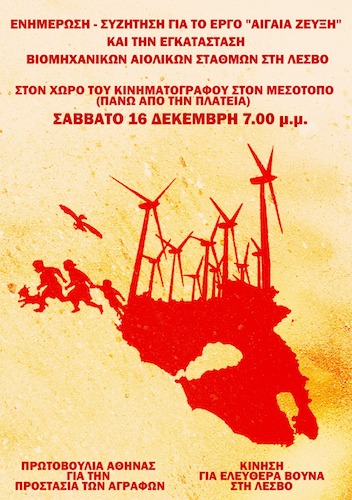In Athens stands the famous Tower of the Winds, a twelve meter high marble building, built in approximately the first or second century BC. The Horologium of Andronicus of Cyrrhus, as the tower is also known, gives you the hour through its sundials. In ancient times it also included a water clock, but this mechanism no longer survives.
That Tower of the Winds would be great in my garden. Not to tell the time, but to tell me from which direction the wind is blowing. The upper walls of this octagonal tower have been decorated with reliefs of the god of the winds. I normally put a wet finger in the air to know from which direction the wind is blowing: South wind (Notus), West wind (Zephyrus), North wind (Boreas) and East wind (Eurus).
The main Gods of the Wind
In Zandvoort, where I grew up on the North sea, East wind means dangerous seas (wind going off land) and jelly fish. On Lesvos I never hear mention of Eurus and I have seldom bumped into a jelly- like monster in the sea. Eurus, the East wind brings mild autumnal weather and wears a cape full of fruit and corn. Eurus used to be loved in Sparta where he is called ‘Savior of Sparta’ because he more than once saved the harvests with fruitful rains.
The other three winds are better known on Lesvos. Zephyros is expected to bring warm winds in spring, making all the emerging greens happy. The West wind on the Tower of the Winds wears a cape filled with flowers and is known as a quiet young man. But when he releases his winds on Lesvos, the sea gets upset and enormous waves bump onto the land, often with plenty of damage.
The South wind Notus has an downturned jug in his hands, a symbol of all the rains he splashes from the heavens onto the earth. He is not loved by the seafarers because of his unpredictable winds that come storming from the south.
The warmly clothed North wind is shown blowing on a huge shell, symbolizing how much noise his heavy winds cause. In Athens they used to venerate Boreas because in 497 BC he helped sink the Persian fleet. In the Greek colonies in the south of Italy they used to offer an ass as sacrifice- just to keep off the mad winds from the north.
Minor Gods of the Wind
The Tower of the Winds however shows four more lesser known gods of the weather: Libs, the South-West wind, in his hands he holds pieces of shipwrecks: he might be a disaster for the shippers, or just a good promise for sailing. Skiron is the North-West wind and seems to be turning over a pot with ash. His summery dry winds are divine food for the wild fires and in the winter he brings the coldest weather. Kaikias comes from the North-East and loves to make the roads unsafe with hail and snow. And there is Apeliotes who wears a raincape. His winds are from the South-East and he is known for plenty of small floods.
Windmill parks
Those Greek islands, blessed with mountains, are with all those bickering winds, pretty attractive to large industrialists. There are many plans to mess up the nature of West-Lesvos, in order to build ten windmill parks, with 153 giant windmills. Their installation alone will cause enormous damage to the landscape and once the huge blades start turning the empire of the animals, especially birds, will also be endangered. All this – despite the fact that Lesvos is a special place for birds and bird watchers.
Ruthless moneymakers do not care if they pollute the sea with huge fish farms, or that they endanger the very existence of the Geopark that Lesvos is*. The island will only get damages and troubles: the ‘green’ energy will go to the mainland (and to the highest bidder) and windmills do not provide many jobs.
Movement for free Mountains of Lesvos
Action groups, like Movement for free Mountains of Lesvos, fight like real-life Don Quixote’s against those windmills. Surely it’s time that the gods come into action too They too are being exploited at the expense of nature and no Greek God should tolerate that!
*Definition of a UNESCO Geopark: a territory encompassing one or more sites of scientific importance, not only for geological reasons but also by virtue of its archaeological, ecological or cultural value. Lesvos is one of the 94 Geoparks of Europe.











